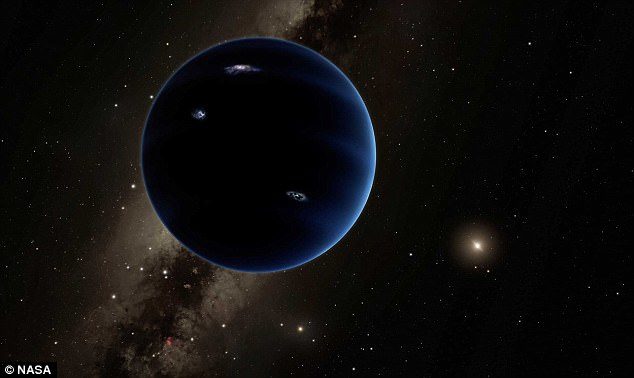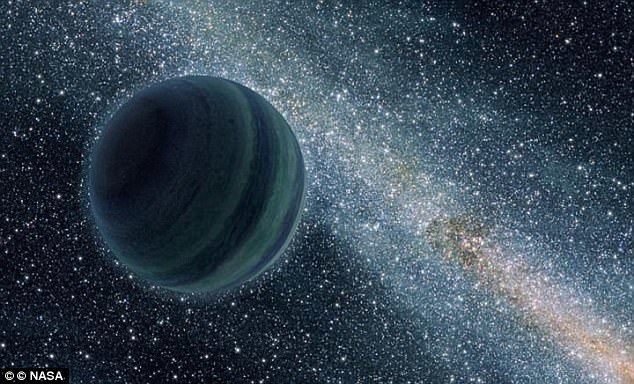
Some astronomers think the existence of the alleged planet - which they claim is 10 times the size of Earth - explains the bizarre way some distant objects in space move.
Now scientists have found new evidence that 'Planet Nine' exists by building simulations of the solar system with different sizes of the celestial body.
They found that the unusual orbits of distant rocks in our system can be explained by the presence of a ninth planet with the dimensions scientists have proposed.
Last week, Nasa highlighted five lines of evidence pointing to the existence of the elusive world, and said that imagining Planet Nine does not exist generates more problems than it solves.
Planet Nine was first theorised by experts from Caltech in 2014 when they spotted that some objects in space, called 'Trans-Neptunian Objects', or TNOs, behave strangely.
These TNOs are rocky objects smaller than Pluto that orbit the sun further out than Neptune.
But the orbits of the most distant of these TNOs - those with 250 times further from the sun than Earth - all point in the same direction.
Astronomers claim that this is explained by the gravitational pull of a ninth planet in our solar system that orbits 20 times farther from our sun than Neptune.
But some researchers say that for Planet Nine to have aligned the TNOs in this way, the small objects would have to be at least a billion years old.
In this time they should have smashed into other planets or been knocked out of their orbits, some astronomers claim, meaning Planet Nine's gravity can't explain their synchronised orbits.
Researchers at the University of Michigan looked at simulations of the solar system both with and without the existence of Planet Nine to see how this might change the movement of TNOs.
In each simulation, the researchers tested different sizes of Planet Nine to see whether that version of the planet, with its gravitational forces, led to the same version of the solar system we see today.
'From that set of simulations, we found out that there are preferred versions of Planet Nine that make the TNO stay stable for longer, so it basically increases the probability that our solar system exists the way it does,' study lead author Ms Juliette Becker said.
'Through these computer simulations, we were able to determine which realisation of Planet Nine creates our solar system - the whole caveat here being, if Planet Nine is real.'

They found that occasionally, Neptune will bump a TNO out of its orbital resonance, but instead of sending that object skittering out of the solar system, something catches and confines it to a different resonance.
'The ultimate goal would be to directly see Planet Nine - to take a telescope, point it at the sky, and see reflected light from the sun bouncing off of Planet Nine,' Ms Becker said.
'Since we haven't yet been able to find it, despite many people looking, we're stuck with these kinds of indirect methods.'
The Michigan team are part of a large cohort of international scientists working to detect Planet Nine, including astronomers at Nasa.
Last week, Nasa announced that there are five different lines of observational evidence pointing to the mysterious planet's existence.
In 2016, Caltech astronomers published a study that examined the orbits of six objects in the Kuiper Belt - a distant region of icy bodies stretching from Neptune outward toward interstellar space.
The findings revealed that the objects all had elliptical orbits that point in the same direction and are tilted 30 degrees 'downward' compared to the plane in which the eight planets circle the sun.
To investigate this further, the researchers used computer simulations of the solar system with Planet Nine included, and showed that there should be more objects tilted at 90 degrees to the plane of the eight planets.
The team realised that five objects already known to astronomers fit the bill.
Following this study, two more clues emerged about Planet Nine.
A second article by the Caltech team showed that Planet Nine could have tilted the planets of our solar system during the last 4.5 billion years.
Finally, the team demonstrated how Planet Nine's presence could explain why Kuiper Belt objects orbit in the opposite direction from everything else in the solar system.
The researchers now hope to find Planet Nine itself using the Subaru Telescope at Mauna Kea Observatory in Hawaii, which they describe as the 'best tool' for the job.



Comment: For a broader, clearer understanding about the nature this celestial body and it's associated effects, read also: Sott Exclusive: Nemesis, not 'Nibiru' - Clarifying mainstream reports about 'a large ninth planet' that periodically sends comets our way